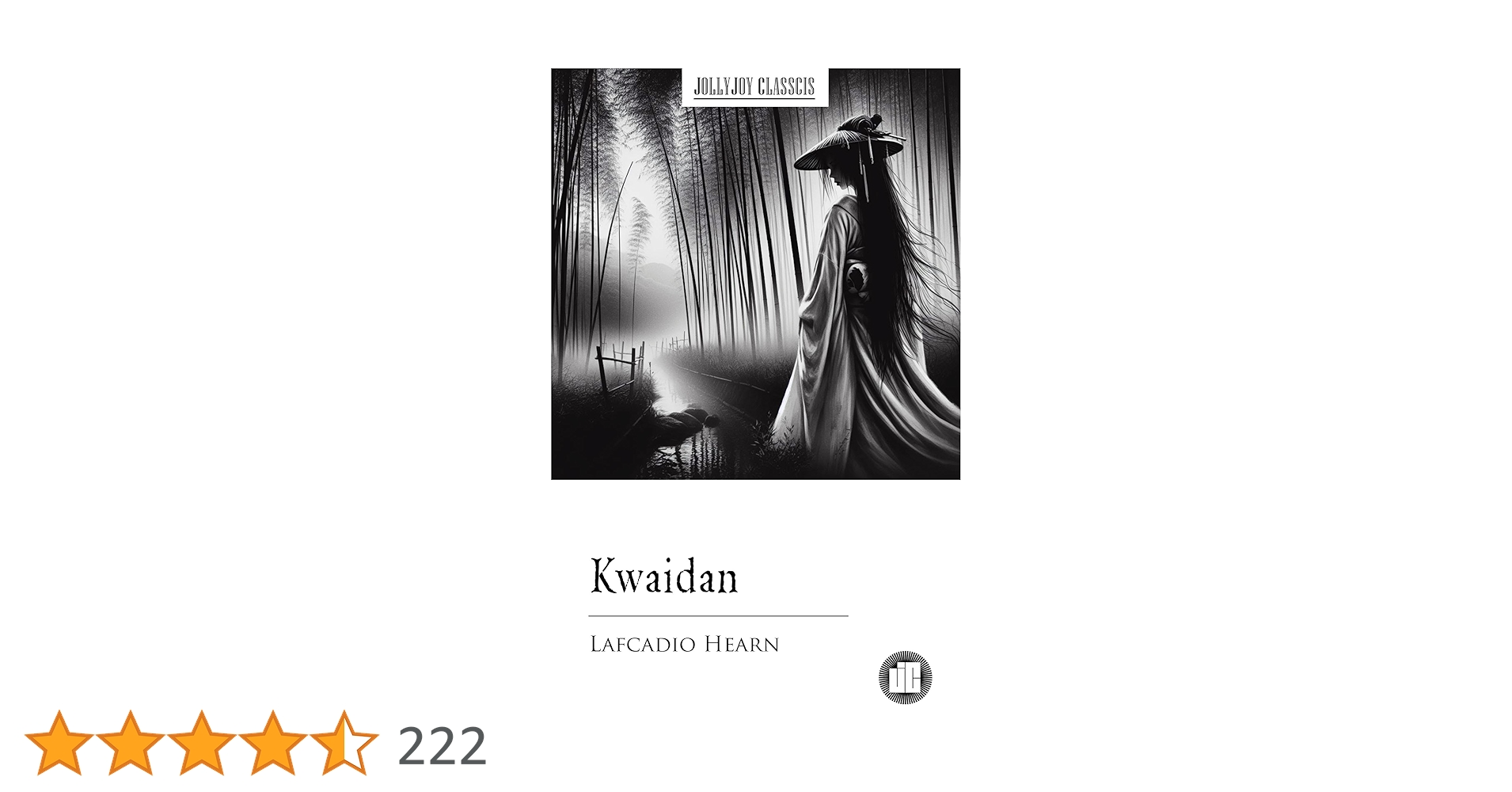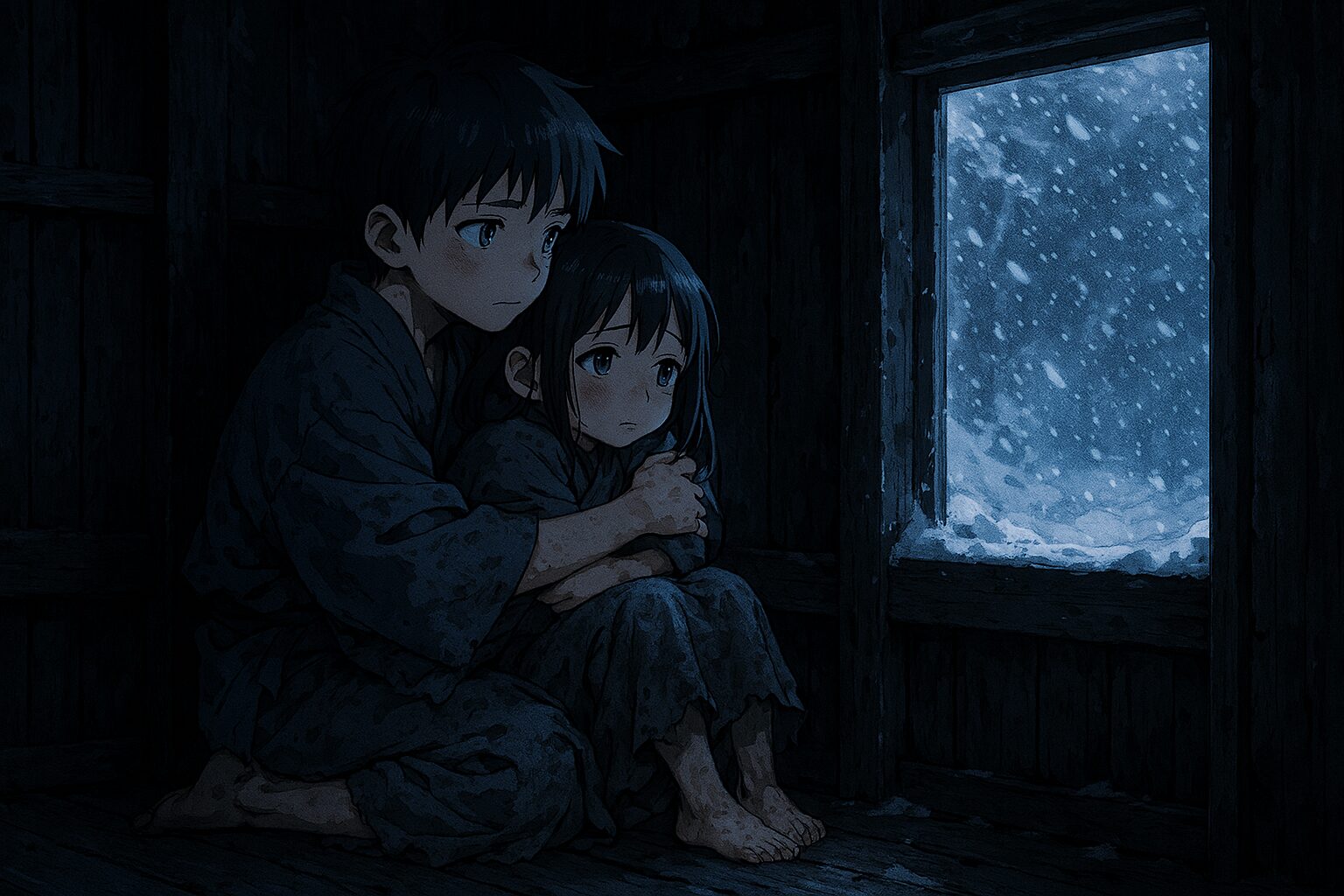
1. The Folktale: Brother and Sister on a Snowy Night
Long, long ago, in a village deep within the mountains, lived a mother and her two young children. Their father had passed away early, leaving the family in extreme poverty. Their house was a dilapidated shack, where drafts blew in mercilessly.
It was winter. That year, a cold more severe than any before attacked the village. The snow fell ceaselessly, freezing even the water jar inside the house. Yet, this family did not possess a single “Futon” (thick Japanese bedding) to keep them warm. All they had were thin straw mats. At night, the mother would pull her son and daughter close, warming them with only her body heat, shivering as they waited for morning.
“Mommy, it’s cold, it’s so cold,” the little sister would cry.
“I’m sorry, I’m sorry. Just endure it a little longer,” the mother would say, weeping.
She made a resolve. “No matter how hard I must work, I will buy these children a warm cotton futon.”
The mother worked desperately from dawn until late at night. She spun hemp, made charcoal, and walked through the snow to the village below to sell her goods. Finally, she saved enough money to buy one futon.
“I am going to town today to buy a futon. You two must keep the fire burning and wait quietly inside,” she instructed before heading over the mountain pass into the heavy snow. The children were overjoyed. “Tonight, we can sleep in a warm futon!” They waited for their mother by the meager fire of the irori (sunken hearth).
However, evening came, then night, and the mother did not return. That night, a massive blizzard struck the mountain. The wind howled, threatening to blow the house away.
“Brother, Mommy is late.”
“She must be taking a long time because she is carrying a big futon,” the brother reassured his sister, though the fire was dying, and the cold was chilling them to the bone.
“Cold… I’m so cold…”
“Come here. I’ll warm you.”
The brother hugged his sister and took off his own kimono to cover her. But the cold only grew more intense. Huddled together, their consciousness fading, they dreamed of their mother.
A few days later, villagers found the mother buried in the snow. She had frozen to death, clutching a brand-new cotton futon tightly to her chest. When they entered the house, the children were nowhere to be seen.
Instead, two birds that no one had ever seen before were perched on the wooden beams of the roof.
The smaller bird cried, “Ani, Futon Kise” (Brother, cover me with the futon).
The larger bird replied sadly, “Ani wa Samui” (Brother is cold, too).
Overcome by the extreme cold and the heartbreak of waiting for their mother, the children had turned into birds. It is said that even now, on nights of heavy snow, the sorrowful cries of these birds can be heard from the mountains.
2. Analysis: Why Did They Become Birds?
This story is a type of “transformation tale” passed down in many regions of Japan. Why does it end with humans turning into birds? There are several deep meanings hidden here.
Transformation as Salvation of the Soul
Since ancient times, Japanese people have believed that souls unrewarded in this life continue to live on in other forms (birds, insects, flowers). By avoiding a direct description of the children freezing to death and instead having them fly away as birds, the story finds a salvation of “eternal soul” amidst the tragedy.
The “Futon” as a Symbol of Wealth
While a futon is a standard bedding item today, in the poor agricultural villages of pre-modern Japan, a thick cotton-filled futon was a valuable asset. In this story, the futon is not just bedding; it is a symbol of “mother’s love” and “unattainable happiness.” The fact that the mother obtained it but could not return, and the children waited for it in vain, sharply depicts the harsh reality of poverty at that time.
3. Decoding Japanese Culture: The Spirit of Endurance
From this folktale, we can decode the spirituality underlying Japanese culture.
“Nintai” (Endurance) and Self-Sacrifice
The brother covering his sister with his own kimono and the mother working at the risk of her life represent the spirit of “self-sacrifice” that Japanese people have long considered a virtue. This mindset of prioritizing others over oneself connects to the modern Japanese concepts of “Omotenashi” (hospitality) and social harmony.
Awe of Nature
In Japanese folktales, nature (like the snowy mountain) is depicted as an overwhelming force that human power cannot control. unlike Western stories which often tend to “conquer nature,” Japanese stories flow with a sense of *Mujō* (impermanence)—living with nature and accepting that one may sometimes fall victim to it. The sadness of this story is the very primal landscape of the Japanese people, who have lived alongside four distinct and severe seasons.
4. A Question for You
After reading this sad tale, what did you feel?
If you were in the brother’s position, what would you have thought in your final moments?
Does your country have tragic folktales themed around cold or poverty? (Like “The Little Match Girl,” perhaps?)
Japanese folktales are not all happy endings. But within that sadness lies the “kindness” and “bonds” that people have cherished. Tonight, as you sleep in your warm bed, please think for a moment about what a miracle that truly is.
Please share your thoughts or similar stories from your country in the comments below.
References
- Japanese Folktale Series (Kiri53.com) – More Japanese Folktales
- Oriental Dollarbird (Wikipedia) – The bird (“Bupposo”) often associated with this legend.

日本の冬は、美しくも残酷な季節です。雪深い山里では、静寂の中に物語が埋もれています。今回は、日本人の心の奥底にある「哀れみ」と「愛」を象徴する昔話、「ふとんの話(別名:ふとんかぶせ、または貧乏鳥)」をご紹介します。この物語は、あなたが知っているハッピーエンドの童話とは異なるかもしれません。しかし、ここには真の日本の姿があります。
1. 昔話:雪の夜の兄と妹 ― 「兄(あに)さん、ふとん着せて」
むかしむかし、ある深い山奥の村に、母親と二人の幼い子供が住んでいました。父親は早くに亡くなり、家族は非常に貧しい暮らしをしていました。家はあばら家で、隙間風が容赦なく吹き込みます。
季節は冬。その年は例年になく厳しい寒さが村を襲いました。雪は降り止まず、家の中の水瓶さえも凍りつくほどです。しかし、この家には、家族全員を温めるだけの「ふとん」がありませんでした。あるのは薄いむしろ(藁で編んだ敷物)だけ。夜になると、母親は兄と妹を抱き寄せ、自分の体温だけで子供たちを温め、震えながら朝を待つのです。
「母ちゃん、寒いよ、寒いよ」
妹が泣きながら訴えます。
「ごめんよ、ごめんよ。もう少しの辛抱だ」
母親は涙を流しながら、決心しました。「どんなに苦労してでも、あの子たちに暖かい綿のふとんを買ってやりたい」
母親は朝早くから夜遅くまで、必死に働きました。麻を紡ぎ、炭を焼き、雪の中を歩いて下の村へ売りに行きました。そしてついに、ふとんが一枚買えるだけのお金が貯まったのです。
「今日、町へ行ってふとんを買ってくるからね。お前たちは家の中で火を焚いて、じっと待っているんだよ」
母親はそう言い残し、大雪の中、峠を越えて町へ向かいました。子供たちは大喜びです。「今夜からは暖かいふとんで寝られるんだ!」二人は囲炉裏のわずかな火にあたりながら、母の帰りを待ちました。
しかし、夕方になっても、夜になっても、母親は帰ってきません。その夜、山は大吹雪に見舞われました。ゴウゴウと風が唸り、家さえも吹き飛ばされそうです。
「兄さん、母ちゃん遅いね」
「きっと、大きなふとんを持ってくるから時間がかかっているんだよ」
兄は妹を励ましますが、火は消えかけ、寒さが二人の体を芯まで冷やしていきます。
「寒い、寒いよぅ」
「こっちへおいで。兄ちゃんが温めてやる」
兄は妹を抱きしめ、自分の着物を脱いで妹にかけてやりました。しかし、寒さは厳しくなる一方です。二人は互いに抱き合いながら、薄れゆく意識の中で母の姿を夢見ました。
数日後、村の人が雪に埋もれた母親を見つけました。母親は胸にしっかりと新しい綿のふとんを抱きしめたまま、凍え死んでいました。そして、家の中に入ると、子供たちの姿はありませんでした。
その代わり、家の梁(はり)の上には、見たこともない二羽の鳥が止まっていました。
小さい鳥が「アニ、フトンキセ(兄さん、ふとん着せて)」と鳴くと、
大きい鳥が「アニハ、サムイ(兄は寒い)」と悲しげに答えるのです。
子供たちはあまりの寒さと、母を待つ切なさのあまり、鳥になってしまったのでした。今でも雪深い夜になると、山からこの鳥たちの悲しい鳴き声が聞こえてくると言われています。
2. 考察:なぜ彼らは鳥になったのか?
この物語は、日本の多くの地域で語り継がれている「変身譚」の一つです。なぜ人間が鳥になる結末なのでしょうか。ここにはいくつかの深い意味が隠されています。
魂の救済としての変身
日本人は古くから、現世で報われなかった魂は、別の形(鳥や虫、花など)になって生き続けると信じてきました。子供たちが凍死するという直接的な描写を避け、鳥になって空へ羽ばたくという結末にすることで、悲劇の中にも「魂の永遠性」という救いを見出そうとしたのです。
「ふとん」という富の象徴
現代では当たり前の寝具であるふとんですが、江戸時代以前の日本の貧しい農村において、綿の入った厚いふとんは高価な財産でした。この物語におけるふとんは、単なる寝具ではなく、「母の愛」そして「到達できない幸福」の象徴です。それを手に入れた母が帰り着けなかったこと、子供たちがそれを待ち続けたことは、当時の過酷な貧困の現実を鋭く描いています。
3. 日本文化を読み解く:寒さと耐え忍ぶ心
この昔話からは、日本文化の根底にある精神性を読み解くことができます。
「忍耐(Nintai)」と自己犠牲
兄が自分の着物を妹にかける行動や、母が命がけで働く姿は、日本人が美徳としてきた「自己犠牲」の精神です。自分よりも他者を優先するこの考え方は、現代の日本社会における「おもてなし」や協調性にも通じています。
自然への畏怖
日本の昔話において、自然(雪山)は人間の力ではどうすることもできない圧倒的な存在として描かれます。西洋の物語が「自然を征服する」傾向があるのに対し、日本の物語は「自然と共に生き、時にその犠牲になることを受け入れる」という無常観(Mujō)が流れています。この物語の悲しさは、厳しい四季と共に生きてきた日本人の原風景そのものなのです。
4. あなたへの問いかけ
この悲しい物語を読んで、あなたは何を感じましたか?
もしあなたがこの兄の立場だったら、最期の瞬間に何を思ったでしょうか?
また、あなたの国には、寒さや貧困をテーマにした悲劇的な民話はありますか?(例えば「マッチ売りの少女」のように)。
日本の昔話は、ハッピーエンドばかりではありません。しかし、その悲しみの中にこそ、人々が大切にしてきた「優しさ」や「絆」が隠されています。現代の私たちが、暖かいふとんで眠れることがどれほどの奇跡か、今夜は少しだけ考えてみてください。
あなたの感想や、あなたの国の似たような物語について、ぜひコメントで教えてください。
参考リンク
- Japanese Folktale Series (Kiri53.com) – 日本の昔話シリーズ一覧へ
- ブッポウソウ(Wikipedia) – 物語のモデルとなった鳥についての解説



コメント